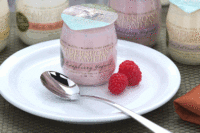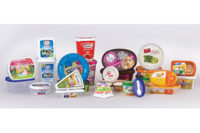
It’s a cinch by the inch but hard by the yard – that’s the philosophy adopted by Brenham, Texas-based Blue Bell Creameries since at least the 1970s, when the company first began to gradually expand beyond the Houston-area market.
In the three-plus decades since, Blue Bell has become the No. 3 ice cream brand in the United States, becoming the favorite of Texans and gaining fans in 18 other states. After a successful entry into the Albuquerque/Santa Fe, N.M., market in March, Blue Bell has now entered Indianapolis via the Michigan-based Meijer grocery superstore chain.
The company has leased temporary distribution space in the Hoosier State’s capital city and plans to have a 12,000-square-foot cold-storage warehouse completed there in the near future. Drivers have already been hired to deliver ice cream to at least a half-dozen cities in central Indiana, according to published reports. Products sold in Indiana will be manufactured at Blue Bell’s Sylacauga, Ala., plant.

Considering the proximity to other major Midwestern markets and Meijer’s locations throughout the region, Blue Bell’s latest move begs the question: Will Blue Bell Homemade Vanilla and other half-gallon flavors soon be available in Chicago-area stores?
The folks at Blue Bell are characteristically mum on such speculation. So until they move that next inch, Prairie Staters will have to be content with the dessert menus at Outback Steakhouses and Carrabba’s Italian Grills, which the processor furnishes with Blue Bell Homemade Vanilla through foodservice channels.

‘We eat all we can and sell the rest'
Meanwhile, Blue Bell continues to do what it does best – make good ice cream that folks continue to buy in great quantity despite their economic woes.“Fortunately, ice cream is still an affordable luxury,” Dickson says. “People may be cutting back in other areas, but for ice cream, they continue to reward themselves.”
The company reports a 7% increase in overall sales for 2009 over the previous year. Blue Bell had packaged ice cream dollar sales of just over $269 million for the year ending Jan. 24, according to data from Chicago-based SymphonyIRI reported by Dairy Foods in its annual ice cream outlook in March. That was a 13% increase over the previous year, compared to a 3.5% drop for Breyers and a 0.6% increase for Dreyer’s/Edy’s Slow Churned, the No. 1 and 2 brands, respectively. (Blue Bell reported total annual sales of $330 million for DF’s annual Dairy 100 processor ranking last August, putting it 51st.)
That’s quite an achievement, considering that Blue Bell products, when not on sale, tend to be premium priced (more complicated varieties are priced higher than simpler ones), because of the high-quality ingredients and the fact it still comes in a full half gallon, while most of the industry has downsized to a 56- or 48-ounce container.

Paul Kruse, president and chief executive officer, adds: “With more home consumption, that favors us.”
And consumers don’t appear to be backing away from their favorite brand, regardless of their economic status. “We’ve gotten a whole lot of letters saying ‘thanks’ [for keeping the half gallon] and if you have to raise the price, raise the price,” Kruse says.
Wayne Hugo, general sales manager, confirms that folks take note of the quantity and quality. “I’ve had people tell me they appreciate it,” he says. “It’s nice they notice it when times are hard.”
The company also benefitted from additional attention as people traveled less, opting to enjoy attractions closer to home. These so-called “staycations” swelled attendance at Blue Bell’s Brenham tour center, especially during spring break. “We shot through the roof,” Dickson says. “We had a big increase in visitors last year.”
The company had to set up tents to accommodate the huge crowds, and even executives jumped in to help direct traffic as visitors pushed parking areas to capacity. “We’ll be more prepared this year,” Dickson remarks.
Even on the day of Dairy Field Reports’ visit in late March, a steady stream of visitors filtered through the center and its gift shop and ice cream parlor, looking to catch a glimpse of the manufacturing process and a few scoops of their favorite frozen treat.
The recession came in the wake of a spike in fuel prices that led many companies, processors and suppliers alike, to levy fuel surcharges to contend with $5 diesel. Blue Bell, whose operations are almost entirely DSD, opted not to do this.

While Blue Bell did not impose a fuel surcharge, “a number of our suppliers did,” Kruse notes. “A lot of incoming freight was affected for a while.”
Breed adds: “We didn’t cut any routes. We’re always trying to be as efficient as we can, but we still need to provide a certain level of service.”
But the company did offer its employees some relief, with up to $100 extra per pay period to help defray their own personal gasoline expenses. “A lot of our people commute to work up to 40 miles,” Kruse says. “We paid them a cash bonus over several pay periods to help them defray some of those costs.”
More significant in the long run than fuel prices, Kruse says, is the ongoing volatility of dairy pricing. “No one benefits from that,” says Kruse, who as past chairman of the International Dairy Foods Association has testified before Congress on economic issues facing the industry. “Hopefully, we’ll get to a point where we can reach a consensus on this and move forward.”

‘Better by a country smile'
So Blue Bell continues to grow, three years out of a centennial celebration that saw a whole year of events including a traveling exhibit that visited cities in every corner of the company’s marketing area.“We wanted to give everyone a taste of what they’d see if they came to Brenham,” says Bill Weiss, public relations manager. “What came from that is an incredible awareness overall. Our crowds here at the tour center have really picked up.”
That’s since more than 30,000 came through a three-day celebration that summer. “All of our employees got to see our company from a different perspective,” Weiss says. “Everyone was pumped up about it.”
The centennial also begat a new flavor that’s still in the lineup: Southern Hospitality – Blue Bell Homemade Vanilla with pineapple, strawberry swirl and pecans – the creation of a South Carolina woman who won the “Taste of the Country” anniversary flavor contest.
If it was on the road today, Blue Bell’s traveling exhibit would have additional ports of call, including Miami, which the company entered in February 2009 after arriving in northern Florida a few years earlier. “It’s probably one of the most successful entries we’ve had – well received by everyone,” Dickson says.
Breed adds: “The grocers were excited about our arrival, gave us good shelf space and promoted our products from the onset, in addition to our own ads, TV, radio and billboards.”
The arrival in south Florida came complete with its own new flavor: Tropical Paradise, coconut ice cream with crushed pineapple, macadamia nuts and a pineapple-coconut sauce swirl.
And the timing was good, Weiss notes. “Here we were, a new company coming into town, leasing a facility and hiring new people,” he recounts. “It was a feel-good story that received a lot of coverage in the local media.”

What's next for Blue Bell, besides Indianapolis?
The company will continue to emphasize the foodservice side of its business, Breed says.“This year, we will introduce nine new flavors in 3-gallon containers. These flavors will be sold to ice cream parlors, restaurants, sporting venues and any other location requiring a hand-dipped operation,” he says. “Some of these flavors will be the same as our half-gallon line, while others will be totally unique for our foodservice customers.”
Beyond that, the plan is to keep doing what they’ve been doing so well. “Our hope is that we can continue to be a large regional player in the ice cream industry,” Kruse says. “We have had the good fortune to gain consumer acceptance wherever we have gone.”
Those consumers have come to expect a high level of quality from the consistent “sophisticated country” image that Blue Bell projects, reinforced with whimsical advertising, a unique flavor lineup and tight centralized control of every step in the production and distribution chain, from raw receiving to grocer’s freezer.
“The outlook for Blue Bell and our industry is good,” Kruse says. “We are part of a fun, put-a-smile-on-your-face industry that looks optimistic from our perspective. Blue Bell will continue to help grow the category by expanding into new markets and introducing exciting new flavors and products that consumers want.”

History
The Brenham Creamery Co. opened its doors in August 1907. In the beginning, the company only made butter, but by 1911 it was making a gallon or two of ice cream a day, packed in a large wooden tub with ice and salt and delivered by horse and wagon to friends and neighbors around Brenham, Texas.All ingredients - milk, cream, eggs and fruit - came fresh from the farmers around Brenham, in Washington County about 75 miles northwest of Houston. In fact, the folks at Blue Bell like to say, “The milk we use is so fresh, it was grass only yesterday.”
By 1930, the company had changed its name to Blue Bell Creameries, named for the blue flowers of the same name that grow in the fields throughout the county.
The Kruse family’s history with the company dates back to 1919, when schoolteacher E.F. Kruse was recruited to head the creamery. Upon his death in 1951, his son, Ed Kruse, became president and chief executive officer, serving until 1993 when his younger brother, Howard, became CEO. Then in 2004, the top leadership post went to Paul Kruse, Ed’s son and Howard’s nephew; Paul had joined Blue Bell in 1986 as its chief legal counsel. Ed continues as chairman, while Howard is president emeritus.
Blue Bell remained primarily a Houston-area favorite until the 1970s, when demand from other areas and reliable transportation made expansion practical and profitable. The next three decades saw Blue Bell’s marketing area expand in every compass direction. Two new manufacturing facilities and dozens of distribution centers have allowed the company to build into the territory it serves today: 19 states at retail, and beyond through foodservice channels as well as mail order for devotees who’ve moved farther than Blue Bell’s normal reach.

The company’s main plant is located next to its corporate headquarters in Brenham, with a secondary plant in town – the original Brenham Creamery – that produces frozen novelties. Blue Bell also operates manufacturing facilities in Broken Arrow, Okla., and Sylacauga, Ala. In addition, the company operates 49 branch facilities throughout its 19-state marketing area.
Blue Bell celebrated its 100th anniversary in 2007 with a year-long celebration that included a traveling exhibit, which put in at cities throughout the company’s marketing territory; a centennial history book; and a three-day festival in Brenham that drew thousands of people. Also in honor of the milestone, Blue Bell launched Century Sundae – Homemade Vanilla swirled with caramel and chocolate sauces, whipped topping and maraschino cherries, in a carton festooned with the images of 100 birthday candles. The flavor remains in the company’s regular lineup.
While a lot has changed at Blue Bell Creameries since 1907, the folks in Brenham say the quality of its ice cream hasn’t changed one bit – appropriate for a company with the slogan, “We eat all we can and sell the rest.”
SOURCE: www.bluebell.com

The Blue Bell Family of Products
Blue Bell Creameries makes a full line of ice cream, frozen yogurt, sherbet and frozen novelties. In 2010, the company will offer 288 unique flavors and products in its portfolio, including 155 packaged ice cream flavors, 18 light and no-sugar-added products, and 96 single-serve and multipack novelties.The lineup of new flavors scheduled to debut this year includes Cake and Ice Cream. Launched in March, the flavor features vanilla ice cream with chocolate sprinkles, chocolate-coated cake pieces and a swirl of chocolate icing. Happy Tracks, launched in April, is vanilla ice cream with chocolate-covered peanut butter cups and a dark chocolate swirl. May will see the launch of Summer Berries, a citrus ice cream mixed with strawberries, blackberries and swirls of raspberry and blackberry sauces. Other new half-gallon flavors will be introduced throughout the rest of 2010.
Also returning this spring is Fruit Special, a unique combination that has been offered on and off since the 1970s, was last made in 2005 and is coming back by popular demand. It’s described as a light, refreshing treat that combines Tutti-Frutti ice cream with pineapple chunks, maraschino cherries, miniature marshmallows and chopped roasted almonds.
Most of the new half-gallon flavors also will be available in pints, which will remain at 16 ounces despite the industry’s downsizing trend.
New snack items for 2010 include Strawberry Fruit Bars, containing 45% real strawberries and delivering 50% of the Daily Value of vitamin C at 70 calories per 2.5-ounce bar. Also available are Cookies ‘n Cream Bars, putting the flavor Blue Bell is widely credited with inventing on a stick; a revamped Mooo Bar (chocolate-coated vanilla ice cream); and 12-pack Sundae Cups, featuring Blue Bell’s popular Homemade Vanilla with a chocolate swirl.
Blue Bell’s product development team meets with marketing and production folks each February to start the process for introducing new flavors, explains Brenda Valera, director of research and development. “We usually have over 100 ideas. By May, we’ll have it narrowed down to 10 or 12,” she says.
Then, samples are made for all company branches to determine what they think would sell best in their areas. “By summer, they have their programs in place for the next year,” Valera says.
Typically, snack items are launched early in the year, followed by packaged flavors. About a half-dozen new flavors are released annually for three months at a time. “If they are successful, they’ll just keep going, or we will bring them back later,” Valera says.
With all the success Blue Bell has had with its many unique flavor combinations, has it ever had a significant flop? Yes, the management team agrees: Peanut Butter & Jelly.
“We all thought it was great. So we came out with it,” Ricky Dickson, vice president of sales and marketing, says of the flavor that lasted a few months in summer 2005. “There are great flavors named after cakes and pies, but not sandwiches. It tasted great, but the name did it in.”


